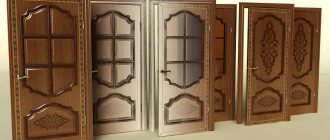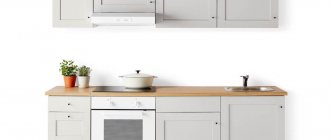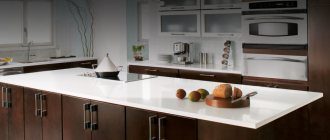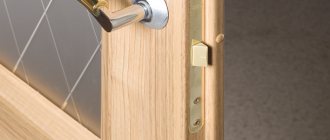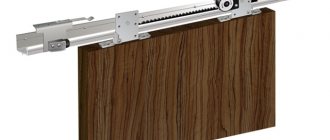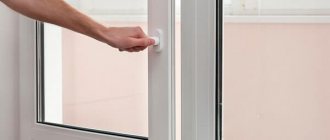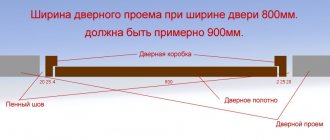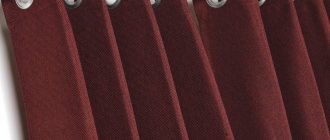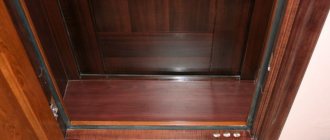This completes the installation. Periodically it will be necessary to check the operation of the hinges and adjust the compression, since the springs weaken during operation.
Installation diagram of spring hinges. 1) spring 2) hole in sleeve 3) stopper 4) screw 5) top nut
Adjusting the hinges must be done extremely carefully, otherwise you risk breaking the spring.
If you did everything correctly, the door will open freely and then attract itself to the frame. It may be necessary to add a couple of degrees of inclination to make the task easier.
We recommend watching the video:
- Instructions for installing double-sided spring hingesDownload 636.89 KB
DOORS - AUTOMATIC | MODEL CONSTRUCTION
There are so many devices that can be invented to make the front door close on its own. These include special spring loops, cargo devices with counterweights and a block system, and all kinds of springs or rubber strips. There are also those produced by industry, however, unfortunately, they are not without drawbacks: some are too complex and quite expensive, others are inconvenient to use or unreliable, and quickly fail. Therefore, home designers continue to solve these problems on their own, as evidenced by the proposed selection of materials sent by readers. In winter, the entrance doors of our houses are often left open. This leads to excessive consumption of energy required for heating staircases. To preserve precious heat, simple automation is needed.
However, you can do without mechanical devices by ensuring a slight tilt of the entire door frame. The main drawback - the door hitting the frame - can be easily eliminated by laying strips of thick rubber along the vertical part of the door frame.
Rice. 1. Spring door closing mechanism:
1 — rubber shock absorber, 2 — door, 3 — spring.
To ensure tight closure, use a device with a weight connected to the door using a cable passed through a block. Depending on the installation location of the latter, the returning moment will either increase or decrease. To limit the angular velocity of the door when closing, the load is placed in a vertical cylinder filled with some liquid, preferably mineral oil. Under the influence of weight, the load will fall in a viscous medium, which will limit its speed and, accordingly, the angular speed of the door. The gap between the pipe wall and the cylindrical surface of the load should be no more than 1 mm.
How to Correctly Install a Spring on a Gate
The simplest model of a gate closer is an ordinary spring, which was attached at one end to the door and at the other to a post. Once upon a time, bulky counterweights on a flexible cable were used, under the weight of which the door leaf slammed shut. To install such return mechanisms, the top crossbar is not needed.
It is almost impossible to achieve smooth closing of the sash without clapping, and it is also difficult for small children to open the door with such equipment.
In modern models of wicket door closers this drawback is eliminated, and the return of the wicket door to the closed position is carried out according to the same principle.
The sash opens under the influence of some human effort, and a piston is set in motion, compressing the spring. It opens immediately as soon as the door is released from pressure. True, today engineers are creating door closers with completely new and original ways of automatically closing doors.
The finishing mechanism for a gate in a country house, which does not have a top crossbar, is installed with one part directly on the sash, and the second on a supporting support, often in the open air. In this regard, consumers have the following requirements for street door closers:
- Ease of use and compliance with safety standards;
- Possibility of adjusting the shutter closing speed;
- Proper functioning under prolonged mechanical loads;
- Trouble-free operation in any temperature conditions;
- Resistance to corrosion when exposed to rain and snow;
- Simple installation of the mechanism, which does not require special knowledge and allows you to install it yourself;
- Possibility of installing it on a gate made of any material;
- A price accessible to almost every owner of a summer house or personal plot.
Types of door closers
Closers operating on a knee or hinge rod are usually not installed on a gate without a top crossbar. The following types of mechanisms are most often used here:
- Pneumatic, operating on the difference in pressure on both sides of a piston moving in the cylinder when the sash opens. The air in front is compressed, and a vacuum arises in the back. This is balanced when the impact on the wicket stops. The installation of such return devices is necessary for the efficient operation of gates with frequent opening.
- Hydraulic closers in which the working fluid is oil. When the spring is compressed, it flows through the piston hole into another part of the cylinder, and when it is decompressed, it returns to its original place in the same way. This transfer of hydraulic fluid ensures soft, smooth closing of the gate.
Electric closers that require an electrical connection to operate the shutter, which regulates the rotation of gears on the levers. When opening the gate, they rotate freely, and when closing, their movement is slowed down by a blocking bolt device or gate lock, which ensures slow progressive closing of the gate. The safety level of using such a return device is very high, which is important for the elderly and children. True, the use of such return devices in the country is not so frequent.
There are invisible door closers that have a tubular shape and are completely built into the door leaf. The lining of the doors, which is important, protects them from vandalism and bad weather. But for such installation, a sash thickness of at least 45 cm is required.
Installation and adjustment
Closers are made of high quality steel. They do not require constantly repeating settings. But if any component fails, then repairing it at home is almost impossible. If all installation rules are followed, they can last quite a long time.
First of all, the gate itself must be reliable, open and close properly. You must not allow it to become skewed or the hinges to become unsteady. To install the return device, you must use reliable fasteners.
Closers intended for indoor use cannot be installed on wicket doors. Installation of a door closer on a gate can be done by every attentive and careful owner, regardless of whether it is wooden, metal-plastic or metal. They are made to open the door in any direction, but to avoid vandalism and theft, the device is placed on the inside of the door facing the house. Begin by marking the support post and the wicket door in the closed position.
The closer is attached in accordance with the instructions that are included with the purchase. The home craftsman may not be satisfied with the supplied fastening material, and he himself finds a more durable and reliable one. After installation, the speed of movement of the sash should be adjusted. Most models have adjusting screws; by unscrewing or screwing them in, you can achieve the desired rigidity of the gate closure.
When leaving or entering, sometimes there is a need to open the gate for a long time. For this purpose, many return devices are equipped with a special button that allows you to lock the sash open or closed. The video shows the work of the door closer.
Instructions. How to make a door closer with your own hands from various materials
A door closer is a very useful thing in everyday life. After installing it, using the doors in your house or apartment will become much more pleasant. In a hurry, did you not have time to close the door? The closer will do this for you - quietly, carefully, without annoying clap.
The door closer is quite easy to make and install with your own hands, you just need to be smart.
- A simple door closer option
- Door closer from car door lift
- Spring based door closer
- Door closer installation
A simple door closer option
To make your own door closer, you don’t need a lot of materials. First of all, before making a closer, you need to pay attention to its weight. To make the simplest design, you will need a weight.
The heavier and more massive the door in size, the heavier the closer should be. Those who are making such a useful household item as a door closer for the first time are advised to determine the weight of the load experimentally. There is no specific formula for calculating the mass of a load.
To make the simplest version of a door closer, you will need a rope or cable, as well as one more element - a wheel, which is necessary to move the rope up and down. The load is attached to the end of the rope or cable - it will pull the canvas.
To prevent the load from hitting the door leaf and wall, spoiling their appearance, it must be placed in a piece of plastic pipe. A weight is placed in the pipe and attached to a rope. Then they attach this structure to the canvas - and the simplest door closer is ready.
Door closer from car door lift
Is your car door broken? Don't rush to throw away the lift. Only three or five lifts from car doors will be needed to make a door closer.
The lifts must be attached to the canvas so that the closure bracket is located between the hinge axis.
This type of door closer is good because its manufacture does not require the purchase of any complex mechanisms.
Even if the doors are wide open, thanks to this closer they will close smoothly and softly.
Spring based door closer
With your own hands you can make another type of door closer for a wooden panel. The base of the design is a spring that gently returns the blade to its original position when opening and closing. Making such a door closer is quick and quite simple, but it is only suitable for light wooden panels, since with prolonged use the spring quickly becomes unusable.
The spring design of the closure can become stronger if it is complicated. But first, let’s figure out what elements are needed to install this structure on the door.
The basis of the closure is a spring. In addition, to slow down the movement of the door you will need a shock absorber.
The door closer shock absorber is designed on the principle of a conventional piston. The shock absorber consists of two chambers filled with oil. When the door is opened, one of them fills with oil. When the door is closed using this design, the oil flows into the second chamber.
There is nothing fundamentally new in the design of such a mechanism. Even a novice craftsman can make such a door closer; the main thing is to correctly manufacture the inside of the device. To allow the oil to flow back, a bypass valve is installed inside the structure. However, you can go the other way by installing an ordinary pump instead of an oil shock absorber.
It is not easy to adjust the pump to the operation of the door. Like a door closer made of a primitive weight and cable, such a door closer can only be adjusted to the functioning of the doors through trial and error.
To make such a structure, it is necessary to select a rack-and-pinion gear, the size of which depends on the size of the structure. It is through it that the load on the spring comes. The strength of the rack and pinion determines how long the door closer will serve you.
For those who do not want to use such complex devices, there is a simple alternative - use a piece of old rubber or a car inner tube as a door closer. Such a door closer can work quite reliably for some time, but it does not look very aesthetically pleasing.
Door closer installation
Installation of the door closer is a very important part of the work. Its functioning depends on how correctly the closer is installed.
So, installation of a closer includes the following actions:
- Determining the door opening angle;
- Using the template from the kit;
- Marking the holes on the frame and the door itself;
- Drilling pre-marked holes;
- Securing the lever with screws;
- Spring adjustment.
How to adjust a door closer
Silent, smooth opening and closing of doors is ensured by service mechanisms. Installed door closers affect the speed and fix the blades in the open position. Models with wind brakes are used at building entrances. The review contains recommendations on how to adjust the door closer and improve the condition and operation of the equipment.
Manufacturers produce two types of equipment:
- cam slide;
- gear lever.
Cam models are intended for lightweight structures only. The “cam” moves along the rollers and puts pressure on the working spring. The mechanism ensures smooth closing.
The most common option is gear lever mechanisms. Energy is transferred to the spring through gears. Such door closers are suitable for heavy doors with combination locks.
Depending on the placement there are:
- top (overhead);
- floor;
- hidden (frame) closers.
The upper models are installed above the sashes. Entrance and facade groups are equipped with models adapted for use in cold or hot climates. Inexpensive devices are equipped with a sliding rod or gear mechanism.
Floor-standing options are attached to the bottom of the door blocks. This is the best option for office, banking premises, shopping and entertainment complexes. The devices are almost invisible to visitors.
Floor structures are often installed under glass, intercom doors that open in both directions. Standard regulators are designed for sashes weighing up to 120 kg. An internal shock absorber prevents the door leaf from hitting the door frame. The shock-absorbing mechanism reduces loads and extends service life.
Hidden structures are placed inside the frame or in the floor. The minimum thickness of the door leaf for installation is 40 mm. Independent adjustment of the mechanisms is almost impossible due to difficult access. Such equipment is intended for premises with increased requirements for interior design.
The devices consist of a housing, a spring, a piston, adjusting screws, gears, bearings, rubber seals, and fasteners. Most models have a metal body. Decorative plastic trim is more often used on models intended for interior doors.
The operating temperature range is -40 – +50 degrees. Fire-resistant structures designed for fire-fighting equipment and bank vaults can withstand fire exposure up to +300 degrees.
The optimal model is selected according to the parameters of the door block. The weight of the sash and the width of the leaf are taken into account. Manufacturers produce various series for indoor and outdoor installation, sliding structures. The housings of outdoor models are protected from vandalism and the ingress of dust and dirt.
Based on maximum load, equipment is divided into several classes - from EN1 to EN7. The class is determined by the weight of the closer, the door leaf, and the width of the opening. EN1 devices are designed for a maximum weight of 20 kg, opening width up to 75 cm, EN7 - for 160 kg and 160 cm.
When choosing, the orientation is taken into account - left-handed or right-handed. The working life is designed for a certain number of opening-closing cycles. The color and design of the selected model must match the interior of the room.
The operating principle of the mechanisms can be:
- hydraulic;
- pneumatic;
- electric.
When the doors open, the spring is compressed and accumulates energy to return the door leaf to its original position. The pressure is exerted by the piston of the traction device. Racks and gears move the piston. The height of the gears is adjusted with screws.
During movement, the piston opens and closes holes for oil overflow. Oil flows through the valve system into the free part of the housing. The straightening spring provides a smooth return stroke. The spring transfers energy to the rod or rack. Thanks to the lever system, the structure returns to its original position.
The rod moves in the oil, pushing the liquid through the jets. The viscous environment prevents movement. The spring continues to act on the rod and the door begins to close. How to adjust the door closer? To change the speed of movement, the cross-section of the jets passing oil is optimized.
When tightening the screw with the oil seal, the gaps in the technological holes are blocked. The volume changes more slowly, the angular velocity of the valve decreases. At the end of the cylinder, the piston reaches a system of holes corresponding to the aftershock (finishing).
In most cases, setting up and adjusting the closer can be done with your own hands. The initial adjustment of the mechanism is performed immediately after installation. Preventative inspections and elimination of minor faults are carried out 2-3 times a year.
How to adjust the door closer? The condition of the lubricating fluid is affected by the state of the environment. Structural parts are subject to constant thermal expansion and contraction. In winter, the oil thickens and the door speed slows down. In summer, the structure heats up and the doors close very quickly. Therefore, the main procedures are carried out during the changing seasons.
Adjustments are made during scheduled maintenance. During the setup process, the optimal parameters are established. With constant temperature fluctuations, the closers are adjusted more often - once every three to four months.
Significant temperature fluctuations destroy the mechanism, causing breakdowns and damage. At the first sign of malfunction, the device is checked. Oil leaks are eliminated and worn parts are replaced.
Important! In case of complex malfunctions, knowing how the closer is adjusted will not help solve the problem. In such cases, the device is returned for repair or replaced with a new one.
The frequency of scheduled maintenance is influenced by the service life of the equipment (old equipment breaks down more often), frequency of use, and the average value of constant loads.
When opening the door, the mechanical energy of movement is transformed by the built-in drive. The reverse process consists of two phases:
Closing moves the door from any initial state to the “15 degree angle with the wall” position. The final finishing phase (finishing) ensures smooth movement of the blade in the cycle “from 15 to 0 degrees”.
The adjustment helps the door block close slowly and reduce the force of the slam.
The closers have two screws that regulate each phase. The screw marked “1” corresponds to closing, and the one marked “2” corresponds to finishing (latching). Some models are equipped with a third screw that regulates the opening and closing force.
The location of the controls and recommendations for handling are usually given in the operating instructions. Typically the screws are located under a protective cover on the front of the case or on the side.
The speed of movement of the sash is changed by tightening the screws. A screwdriver is required for adjustment. Before starting work, the canvas is opened completely and fixed.
How to loosen a door closer? Turning the screw counterclockwise slows down the blade. The clap should be slow so that the canvas does not break against the box.
Spring hinges: selection and installation
Spring hinges belong to the category of hidden double-sided awnings and have several names: bar, subway, western. Their distinctive feature is the ability to open the door in any direction, which is why they are also called pendulum. The scope of application of such loops is in places with high traffic: bars, shops, medical institutions, industrial and retail premises. The installation of these elements has some features, which you can learn about by reading this article.
Spring hinges are usually installed in high traffic areas
Types of door hinges
The first door hinges in human history were made from animal skin, tree branches tightly woven together, and only much later - from a rough metal plate. Today, door canopies perform not only a practical function, but also a decorative one, decorating the door and the interior as a whole. Types of canopies differ according to several criteria:
- the material from which they are made (steel, brass, bronze, etc.);
- installation method (overlay, screw-in, insertion);
- design features of the mechanism (overhead, mortise, hidden, corner, double-sided).
Let's look at the last classification in more detail:
- Invoices. Hinges of this type are the most popular, due to their ease of installation and low cost.
To install overhead hinges, it is enough to secure them with self-tapping screws on the surface of the door frame and the door itself.
- Mortise. The design of these hinges is almost identical to overhead hinges; the only difference is in the installation method: hinges of this type are cut into the surface of the door.
Installation of mortise hinges requires experience with a chisel
- Screw-in, hidden. These are not the most popular hinges, which is explained by the fact that they are quite difficult to install (inside the frame and door leaf), and after installation, the door leaf cannot be removed without completely dismantling the hinges.
If it becomes necessary to remove the door, you will first have to remove the hinges
- Angular. They differ from all others by the absence of classic cards. Instead, corners are fitted to the central hinge. The advantage of such hinges is the possibility of installing hinge doors on doors with a rebate.
The advantage of corner hinges is that they can be installed on rebated doors
- Double sided. Outwardly, these canopies are similar to ordinary card canopies, but they have their own fundamental differences.
Spring hinges differ from simple double-sided hinges by the presence of a spring
Door lock: device design
To ensure that the door closes securely and no one can enter the room, a door lock is installed, a device specifically designed for closing doors. Entrance and sometimes interior doors are equipped with locks. According to the functional purpose, various door lock systems are manufactured.
Diagram of a mortise door lock.
Some features of locks
According to the fastening used, locks can be divided into two types:
- invoices;
- mortise
Do-it-yourself installation of overhead locks is done on the inner half of the door. Mortise locks are installed directly into the thickness of the door leaf.
The main parts of each castle are:
- execution system;
- secret.
The device that identifies the key is called a secret. It can be of two types:
- electronic;
- mechanical.
Diagram of a deadbolt lock.
Castles are also classified into several different groups. It all depends on the secret used. Several different types are known:
- levelers;
- cylinder;
- disk;
- coded.
Each lock has an individual mechanism. It, in turn, is divided into:
- mechanical;
- electromagnetic;
- electromechanical.
Mechanical locks are most often installed in the door leaf. The lock is a steel rod, which is directed into a plate that has a special groove screwed to the door block. As a result, the door is securely locked.
In electromagnetic locks, the lock is a powerful electromagnet that is attracted to a steel plate fixed to the block. An electromechanical lock is an ordinary deadbolt with an electric drive.
Certain factors influence the security of a lock. Firstly, it must have a high degree of secrecy, and secondly, its body must be highly durable. The thicker the metal from which the lock is made, the more reliable it is. Of course, interior doors do not require the installation of an expensive and powerful lock. Much more important is its appearance and a beautiful handle.
Very often, door locks are made with a mechanism to lock the door when it is closed. The most common today are:
Diagram of a double cylinder lock.
- crossbars;
- invoices;
- mortise;
- latches.
Do-it-yourself installation of mortise door locks is done directly into the door leaf. Therefore, they are completely invisible from the outside. Mechanisms equipped with a safety device are considered more reliable. When the handle moves, the cam moves. He presses down on the latch, causing it to move back. At the same time, the spring is tensioned. After the handle returns to its original position, the cam, under its pressure, returns to its original state. When the door closes, the latch moves only due to the bevel. The spring is activated independently and the latch slams shut.
In the design, the latch spring also performs the locking function. When pressure is applied to the latch, the second spring latches the bolt. When turning, the key begins with its bit to first lift the latches that fall out of the upper holes. The beard then presses on the bolt and pushes it forward. When the bit returns to its initial state, the latch again enters the upper hole, preventing the bolt from operating automatically. The lock has the ability to work with double closure, because the crossbar is equipped with two niches at the bottom.
Locking devices have varying degrees of secrecy. They are divided into:
- suvaldnye;
- levelers;
- cylinder.
Diagram of the disk lock device.
In systems of the first type, reliability is achieved due to protrusions of different shapes made on the plate. Sometimes there are about 90 such protrusions.
Level devices, invented by the Englishman Chub, are equipped with increased secrecy. In each lock, the key has special recesses located at 90° to the bit. The steel box is equipped with spring plates of different sizes. The locking bolt may operate if the key begins to lift and grip the plates at the same time.
The cylinder lock has increased reliability thanks to a cylindrical channel made specifically for the key. The pins together with the spring prevent the key from turning. If the inserted key can lift all the pins, the locking device will rise, allowing the cylinder to rotate. Such cylinder mechanisms are considered mortise and can be closed in the usual way. It must be said that cylinder devices are considered the most reliable. The keys in this case have different shapes and a huge number.
How does the lock mechanism work?
Any device designed for locking must necessarily consist of:
- locking mechanism;
- steel box;
- valves;
- key
Door lock diagram with security panel.
In locking mechanisms, the most common is the mortise lock. He must have:
- frame;
- face strips;
- a bolt equipped with a special latch;
- main action deadbolt;
- drive lever.
Any lock is equipped with a secret system that identifies the key. The door is locked using an actuator.
Secrets are divided into several mechanical types:
- Cylindrical. Its main part is a special cylinder. It contains pins that prevent the device from being hacked. This castle began to be called English. It is considered the most popular and most in demand.
- Suvaldny. The key of this lock has special teeth. They are designed to identify levers and determine their number.
- Coded. In this case, a secret set of numbers is entered and the protection system is activated. The lock opens.
- Electronic. It operates on a drive, which is installed in the locking device itself.
Actuators are similarly divided into several types:
- Electromechanical. They have a deadbolt powered by an electric motor.
- Electromagnetic. In this case, the locking mechanism is a magnet.
- Mechanical. The steel rod fits into a special hole and closes the lock.
Level lock design
The reliability of a given system directly depends on the number of plates. The more plates, the stronger the protective properties.
The lever system includes the following parts:
- cross bolt or bolt;
- steel plates or levers;
- a special hole where the key is inserted.
The operation of this system is based on installing the plates in specific positions, only then the key will begin to turn.
How does the cylinder system work?
A similar design, similar to others, can be:
- mortise;
- overhead.
Door latch diagram.
The secret mechanism is hidden in the cylinder installed in the center of the lock. This system has several subtypes:
- unilateral;
- bilateral.
One-way system can be opened with a key, and only from a specific side, the other is equipped with two cylinders. This lock cannot be opened from the inside without a key.
Locking a building with a cylindrical device requires several specific steps.
First, the key must be inserted into a groove that has a limited protrusion, which is located in the cylinder.
One of the cylinder parts is always free to rotate if the inserted key fits. The body of such a design is always motionless. The actuator is the pins, and it is them that the key begins to lift. Due to the position of the pins, the operation of the device is regulated. For the mechanism to open, all encryption details must match.
Features of spring hinges
A double-sided spring hinge is fundamentally different from a classic card hinge and consists of two cards on pins, inside of which a spring is installed that returns the door leaves to their original position. Depending on the direction of opening of the door leaf, spring hinges can be: left-handed, right-handed or universal. Left-handed - opens only on the left side, right-handed - on the right, universal - in both directions. Bar canopies have their own characteristics, advantages and disadvantages.
Advantages
The main advantage of bar hinges is their ergonomics, as well as the high throughput of doors equipped with them. The double spring hinge has the following advantages:
- ease of opening the door (using the body) when your hands are busy;
- preventing heat loss in the room through the door;
- the possibility of unhindered passage of a large number of people;
- preventing the formation of drafts in the room;
- automatic door closing.
Flaws
Door spring hinges, well made and installed correctly, have only one drawback: cost. The price of such canopies is several times higher than the cost of classic card canopies.
Bar doors: pros and cons
Bar doors are a clear example of the use of door springs. The popularity is due to the frequent use of hands and high cross-country ability. Bar doors, which are quite popular, have their pros and cons, which are worth paying attention to if you want to have a similar installation.
Pros of bar doors:
- With large flows of people, bar doors are an indispensable design;
- You don't need to put a lot of effort into moving the doors;
- Availability of installation in a residential area, even including the presence of a small doorway;
- At high humidity, the material does not respond to temperature changes and lack of moisture;
- A material that is not harmful to health and is made using purely environmental methods;
- Availability of self-installation, eliminating problems and difficulties;
- Possibility of saving economic costs.
You can install bar doors yourself
The disadvantages of bar doors are that for the doors to operate easily, they require as much free space as possible. Bar doors cannot be installed in the same frame as doors with classic hinges, as the door systems are different.
The area on the door that receives the impact should most often have a bump stop on it, allowing the door to provide more resistant and durable performance.
The lack of sound insulation is relevant, which is why the use of bar-type doors is rare in residential premises. But in such situations, spring hinges can provide comfortable movement.
Criterias of choice
Choosing spring hinges is no more difficult than regular ones: the main thing is to know what to pay attention to. The first and main criterion for choosing canopies does not imply aesthetic qualities or even the quality of the products.
Let's consider the selection algorithm step by step:
- The first thing you should decide on when purchasing hinges is the direction in which the door opens: hinges can be right-handed, left-handed, or universal.
- The second most important criterion is the width of the part. It should also be remembered that spring hinges are selected in accordance with the width of the door leaf.
- The third thing you should pay attention to is the load weight that the loop is designed for (from 25 to 60 kg per loop). Depending on the weight of the door leaf, you may need from 2 to 4 hinges.
- Fourth: aesthetic qualities. Products may vary in length and color. The most common sizes are: 75, 100 and 125 mm; colors: brass (matte and polished), chrome (matte and polished), bronze.
Models made in antique design
In addition, when choosing, you should pay attention to the following possible options:
- possibility of adjusting the door closing speed;
- the presence of bearings ensuring soft, smooth and quiet running.
It is worth paying attention to products from trusted brands
Features of butterfly hinges
Since butterfly hinges do not cut into the door leaf, but are attached from above, the preparatory work that is necessary when using standard hinges becomes unnecessary.
pros
Simplicity of installation allows you to hang doors easily, quickly, and without much difficulty. Butterfly hinges installed on an interior door have an interesting appearance: a little vintage, but very elegant, and add a unique flavor to any door. The low cost of this fastener makes it accessible to absolutely everyone. Fast installation. The hinges are quite reliable and durable.
With proper initial installation and careful operation, they can last for many years. Butterfly hinges make it possible to hang doors on both the right and left sides, regardless of the width of the doorway. In general, for interior doors this is the best option: fast, convenient, aesthetically pleasing and completely reliable. It may also be useful for you to learn about the types of warm doors for a private home.
Installation of spring hinges
The installation of spring hinges is not much different from the installation of conventional hinges of the overhead and mortise types. The sequence of actions is as follows:
- At the end of the door, as well as on the door frame, marks are made about the location of each half of the hinge.
- After this, the stopper should be removed from both cards, this will release the spring.
- Next, insert a pin (mandrel) into the hole on the bushing and turn it clockwise.
- The hinge plates are applied to the base and fixed with self-tapping screws according to the diagram below.
Before installation, the spring loop relaxes, and after completion of work it contracts.
- After this, you need to compress the springs. To do this, the door is closed, the pin on each card is turned clockwise and the stopper is inserted.
- First of all, the springs are screwed to the door leaf, and then to the door frame.
Intermediate stage for installing bar hinges
- Upon completion of work, you should check the smooth movement of the door and, if necessary, adjust the spring.
- When tightening the loops, it is important not to overdo it, since the spring is very easy to break. At this point the installation can be considered complete.
Spring hinges are often installed in restaurants and bars
To clearly understand what spring hinges are, as well as the principle of their installation, it is recommended to watch the video.
How to repair the front door handle?
We use the door handle on the front door every day. It is not surprising that sometimes breakdowns happen to it. If there is a serious problem, it is better to contact customer service. But if the manufacturer does not have such a service, we will tell you how to fix the handle yourself.
We do not recommend repairing door components yourself if the manufacturer's warranty period is still valid. In case of breakdown, contact customer service.
If the entrance handle is just loose, then just tighten the screws with a screwdriver. But often the breakdown turns out to be much more serious. First, let's define the types of input handles.
Types of door handles
- push buttons activate the lock latch
- stationary ones simply pull the door towards themselves.
If the stationary handle is broken, then usually it can only be replaced completely. But the lever handle consists of many elements. And if one fails, you just need to repair it.
Door handle device
- the pressing part that you grasp with your hand
- plastic ring
- door handle base
- return spring
- handle travel limiter
- retaining screw
- square
- some designs also have a cylinder mechanism.
The design is not the most complicated, so you can handle some problems yourself.
How to disassemble a door handle with your own hands?
The handle squeaks when pressed
- unscrew the mounting plate using a screwdriver
- disassemble the mechanism
- lubricate all metal parts, such as WD-40
- reinstall the handle.
The lock latch does not work
This happens when the latch tab stops working or the pin that operates the latch is not long enough.
How to check? You need to unscrew the fastening bar and check whether the lock tongue works. To do this, insert a screwdriver into the lock slot and turn it.
- buy a new pin at any hardware store and cut the required length
- Place wood chips or pieces of thick cardboard into this socket (on the end side of the handle) to “extend” the existing pin.
The pressure part of the handle fell off, but the mount remained in place
- or because the ring burst
- or because it has unclenched.
You need to check what exactly happened in the following way - unscrew the fastening bar and look at the condition of the ring. If it is whole, then bend it further. Then return the handle to its place and put the ring on top.
If the ring has burst, then you can only buy a new door handle.
Door handle square broke
If the door handle falls off or does not stay in the grooves, this may be due to a broken square inside the structure. The square is the base of the door handle. The main advantage is that the square can be purchased and replaced.
Choose a new square made of steel, preferably from the manufacturer of your door handle, so that it fits in size. If you can’t find it, you’ll have to cut it with a grinder to the size of the old square.
The handle does not return to its original position after pressing
This happens when a spring falls off or bursts. This part is located behind the retaining ring and connects all structural elements together.
To repair the spring, remove the retaining bar, remove the retaining ring, and secure the spring. If the spring has burst, you can replace it. But often finding a similar part becomes problematic. In this case, you need to buy a new handle entirely.
The cylinder mechanism is rusty
Some door handles have a cylinder mechanism that is needed to close the door from the inside without a key.
Such a cylinder may rust and turn poorly. This makes it difficult to press the handle and open the front door. Sometimes, due to severe corrosion, the door completely jams.
- remove the mounting strip
- arm yourself with WD-40 lubricant
- lubricate through the cracks next to the cylinder - the entire lock should be lubricated
- After that, wait 10 minutes and wipe off excess lubricant with a lint-free cloth. If lint gets stuck in the lock, it will jam so much that you will have to buy a new one
- pour more lubricant onto the lock and turn it. This must be done slowly and carefully so that the cylinder is not damaged.
- When the lock is completely closed, it’s done!
So we have looked at the main reasons for the breakage of the front door handle. If your door handle still doesn’t work after all the checked reasons, then the damage is serious and you won’t be able to fix it yourself. Contact a professional technician or replace the entire door handle structure.
Installing an entrance door with your own hands Installing a door affects security, noise and heat insulation. Installing an entrance door is a complex process, so it is better to entrust it to professionals. Any violation can deteriorate the properties of the door. For example, the door will no longer keep out cold and loud sounds, and drafts will appear in the apartment. Poor installation sometimes leads to damage to the door structure, and this is no longer safe.
It is possible to install the front door yourself if you strictly follow the rules. How to install a door - we tell you in the article.
has a wide partner network, including in cities such as Moscow, St. Petersburg, Novosibirsk, Voronezh, Saratov, Samara and another 120 cities in Russia and the CIS countries.
www.torex.ru is the official website of the Torex company. This website is for informational purposes only and under no circumstances constitutes a public offer as defined by the provisions of Article 437 of the Civil Code of the Russian Federation. To obtain information about the cost of Torex products, please contact official dealers.
Prices in showrooms may differ from prices on the website. For current information on the cost of Torex doors, check with official dealers in your city.
The manufacturer reserves the right to make changes to the list and specifications of products at any time. For valid product information, please contact authorized dealers.
* All fields are required
By clicking on the button, you consent to the processing of your personal data User Agreement
Portal about construction
01/18/2019 admin Comments No comments
To protect the door from premature failure, closers are often used. These devices are designed to smoothly and accurately slam the door leaf. A specific model is selected based on many factors:
- temperature changes;
- expected load;
- the weight of the canvas itself;
- required level of reliability.
Often such mechanisms cost a lot, and if for external doors this is justified by the reliable service of purchased devices, then for internal doors or a summer house it is more economical to make a homemade closer.
How does the closer work?
A standard door closer is divided into three components:
- main fastening body;
- barbell;
- fastening element.
There is a spring inside the device body, which compresses when the door is opened. As soon as the canvas is released, it will begin to return to its original state. A special composition helps slow down this process and make it smooth - due to its viscosity, it prevents the door from abruptly slamming.
One of the internal mechanism options
The case has two compartments, in one of which the composition remains as long as the door is closed. When the composition changes, the oil flows into the second compartment, where the spring movement is inhibited.
The spring is closely connected to the rod - a movable element of the mechanism that connects the main body and an additional one - attached to the wall or door (depending on the model).
How to install butterfly hinges on doors yourself
For those who do not know how to embed hinges into an interior door, let us explain that this process consists of the following steps:
- applying special markings for hinges to the surface of the door leaf, as well as to the surface of the door frame;
- using a drill to drill holes for hinges in pre-marked places;
- checking the tightness of the door connection;
- checking the functionality of the door.
How to secure the door frame and install butterfly hinges on the interior door will directly determine their service life. The color range is not that wide. Most often there are imitations of various metals. In particular, copper, gold, bronze, or nickel. Butterfly door hinges can be either matte or glossy.
For those who do not know how to install hinges on an interior door, we provide detailed instructions.
Apply markings to the surface of the door leaf and the surface of the door frame;
- Install the rotary axis, which is the main structural element and which ensures the functioning of the entire mechanism.
- Measure 20 cm from the top and bottom edges of the door.
We make markings
- Place the loop at the mark.
- Attach the plates using self-tapping screws.
We attach the hinge to the box:
- insert the canvas into the box, in the same way mark with a marker the location of the other part of the loop on the outer border;
- place one part of the butterfly in place, circle the points for the holes with a marker;
- carefully drill holes, place the product in place and fasten it with screws;
- unscrew the loop from the end, then attach it to the outer area, use an awl to mark the locations for the holes;
- make holes and secure the hinges with self-tapping screws, first attaching the inner part of the hinge, and then attaching the outer side to the box.
This design is suitable for almost any type of door leaf, with the possible exception of heavy solid oak doors. Hinges for heavy doors are slightly different from ordinary ones; they have a thicker flange and have built-in bronze bushings.
For greater clarity, we recommend watching a selection of videos on installing butterfly hinges.
Solving possible installation problems
Since the ideal installation of this type of fastener is possible only with a perfectly flat door leaf (which is rare), some shortcomings may arise during the work: non-critical, but nevertheless requiring correction. We'll tell you how you can correct possible defects that appeared during the installation process.
It is important to correctly set the gap between the door and the frame
The most common problem when installing butterfly hinges is the gap between the hinge plate and the door frame. If there is such a defect, this means that the door will not be able to close tightly, which over time will lead to loosening of the structure and rubbing of the threshold. A small spacer made of cardboard, wood chips, or rubber band (even a match can do) solves this problem. The presence of such a gasket will slightly worsen the quality of installation, however, it will successfully solve the gap problem. If you are not satisfied with the fact that the butterfly hinge plates close too tightly, you can “drown” one part of the hinge a little into the thickness of the door frame.
What functions should the slamming mechanism perform?
Before you make an automatic door closer with your own hands, you need to have an idea of what it should ultimately provide. The main function is shock absorption - preventing the door leaf from hitting the frame. Along with this, the following functionality is highlighted:
- adjustment - the ability to set the closing speed;
- attraction - if the closure is not tight, the mechanism will close the door itself;
- fixation - the ability to fix the closer in one position.
The last point is not mandatory for factory models either, so in the homemade version, any suitable objects are used as a stopper.
Its closing mechanism must attract and smoothly close the door. For these purposes, ready-made parts from cars or improvised means are used.
Car door closers
The trunk of a car is an ideal example of using an automatic closer. Smooth opening, closing and shock absorption make this part a worthy alternative to factory models.
Fasteners are attached to the part. Depending on the design, these can be brackets of various types. With their help, the finished device is attached to the door and wall (or frame).
Springs from a car closer
The advantage of this method is the ability to fix the door leaf in the open position: other homemade closers acquire this function only with the help of additional devices.
You can get the part in your car, by asking friends or at the market. It is cheaper to buy a used working part than to purchase a factory model of the slamming mechanism.
Door stop
Another useful device that has different names is a door stop, stopper or door stop. Its purpose is to protect the wall and furniture from being hit by an opening door. But sometimes it is necessary to hold the door open, and mobile stops can help here. This stopper is a thin plate with anti-slip fasteners attached to the ends. When used, the plate is slipped under the canvas.
When door springs with high tension are used, the mobile stopper may not be able to cope with the load and may not hold the door leaf. Therefore, in cases where a lot of force is required, it is best to use a closer with the ability to fix at a given point as a door return device and at the same time a closing limiter.
Rubber door closers
To make such a door closer with your own hands, the thrifty owner will not have to spend money. They can act as an attracting and shock-absorbing device;
- pieces of rubber;
- pears;
- hoses or tubes.
An example of pipes suitable for use
Located on the door leaf, these elements are easily deformed when the door is opened, but just as easily restore their shape, ensuring the door closes.
The advantage of this type is its cost, ease of installation, and the ability to regulate mechanical force. Rubber has different densities, which allows you to select the best options for a particular door. The only drawback is that it is not aesthetically pleasing, since a piece of rubber or a pear as a closer does not look very attractive. However, for storage rooms and other non-public premises this is the best option.
Homemade devices
You can use improvised materials as homemade devices. In most cases, these are various rubber products - ranging from pears, tennis balls and ending with pieces of car inner tubes. The appearance of such a device is unpresentable, but it will cope with its functions. It can be used for gates in country houses or for gates of outbuildings.
A more reliable and visually attractive option would be to use thin steel plates. To install the plate, it is enough to drill a hole at its ends and secure it, preferably with long self-tapping screws, so that it does not tear off when tensioned.
Springs as a slamming element
One of the simple and affordable ways is to install a spring as a closer. The advantages of this method include:
- ease of installation;
- availability;
- possibility of exposure regulation;
- relative aesthetics.
Springs have a number of characteristics, due to which the optimal option is selected. There is no clear formula for which spring to use for a door of a certain weight. Therefore, you will have to choose empirically.
Simple spring mechanism
Installation involves installing one end of the spring on the door leaf, and the other on the frame or wall.
Installing a butterfly hinge on an interior door
There are different hinge mechanisms, but perhaps the easiest to install in a wooden door are butterfly hinges.
The hinge mechanism, by and large, is extremely simple and is responsible for opening and, accordingly, closing the door leaf, as well as ensuring that it fits as tightly as possible to the door frame. In order to correctly install hinges on interior doors, before proceeding directly to the installation process, you should pay special attention to their design. If it seems too complicated for you, then it is better to entrust the process of installing butterfly hinges on interior doors to professionals.
Using a weight as a slamming mechanism
This method is becoming one of the oldest and is rarely used today. With this method, a cable or rope is attached to the door leaf, the second end of which is passed through a wheel attached to the wall or frame. A weight is attached to the end, which closes the door. Its weight has to be selected manually, since there is no exact formula for calculating it.
The advantages of this method include its low cost, simplicity and efficiency. If necessary, you can even lock the door.
The obvious disadvantage is that while moving, the load swings and hits the door or frame. In order not to spoil the surface, it is placed in a pipe with the appropriate diameter. This approach will preserve the door and give the composition a more attractive and neat look.
A little about the types of loops
Regular hinges need to be cut directly into the door leaf itself. But in order to do this, you need to have professional skills. Otherwise, there is a high probability of damaging the door. The standard installation of hinges in interior doors with your own hands is a rather complex process that not everyone can do. For this reason, it would be better to entrust this matter to professionals.
There is a solution - butterfly door hinges are overhead, have a very attractive appearance, as well as relative ease of execution. The process of installing such hinges on interior doors can be carried out in several ways. This will depend, first of all, on the type of construction of the butterfly hinges themselves, the type of door leaf, as well as the type of door frame.
Such door hinges are called “butterflies” because their plates are shaped like butterfly wings. They are also called card plates, because one plate is inserted into the cavity of another, which is very reminiscent of the process of shuffling playing cards.
After installation, such hinges look very attractive and neat. The process of installing them is quite easy and simple, because they do not need to be cut into the door leaf, but rather just lay them on its surface and screw it. This procedure can be carried out independently.
Mortise hinges for interior doors are a compact mechanism, made in the form of a cylinder and divided into two parts: one for the door leaf, and the other, respectively, for the door frame. The plates themselves are quite easy to install. However, it is very important to choose the right mechanism based on the total weight of the door, as well as the material from which it is made (plastic, steel, aluminum). The difference between them is mainly in the number of pins. As a rule, there are two of them. But in some cases there may be three or even four.
Hidden hinge designs for items
Sometimes there are situations when door hinges absolutely do not fit into the overall interior of the room, as well as into the design of the door leaf. In such cases, special hidden mechanisms are installed. They have a design that is significantly different from the design of conventional door hinges. After closing the interior door, such hinges will be completely invisible from the outside, because they are mounted in the end part of the door leaf.
Type of hidden hinge design
The complexity of the design of hinges with a hidden mechanism is as follows: the central axis is rotary; the fixed axis is also rotatable, which makes it completely invisible on the surface of the door leaf even when the door is completely open; In the process of opening and closing the door, moving axes are activated.
The advantages of door hinges with a hidden mechanism include, in particular, their versatility (suitable for interior doors of absolutely any type, often pre-installed); and the ability to see the hinges only when closely examining the door leaf.
Homemade or factory made?
Factory closers have an undeniable number of advantages:
- easy adjustment;
- aesthetics;
- increased reliability.
In fact, their only drawback is the price: it is unwise to spend a lot of money if you need to take care of closing the door leading to the cellar, pantry or garage. In such situations, homemade analogues come in handy. With proper installation and assembly, they regularly perform the functions of a door closer, and at the same time, the cost of creating such an analogue is often limited by the price of the part itself.
What is a door spring and what types are there?
There are several options for solving the problem of automatically closing doors. The simplest of these is to install a door spring. This is a very cheap device, easy to install and replace. It is a regular steel spring, which is attached to the door at one end and to the wall at the other. When the leaf is opened, the spring is stretched, which ensures its return to its original position. The closing force depends on the rigidity, length, number of turns, diameter and other characteristics. Springs are the most reliable and durable type of closing mechanism. It is not afraid of temperature changes, high humidity, mechanical stress and vibration.
In addition to the classic spring mechanism, there are several more modern solutions that provide automatic return of door structures:
1. Door closers. These devices are equipped with a spring mechanism, which is enclosed in a housing. The design also includes an oil or other type of shock absorber designed for smooth movement of the door leaf. It prevents the loud slamming and sudden closing of doors that is typical of a conventional spring. Some models of door closers allow you to adjust the maximum opening angle and closing speed of the door, and have the function of fixing the door leaf in the open position. Depending on the type of spring used, devices are divided into two types: gear-driven and sliding-rod. The first type has a simpler and more compact design. The second option is more cumbersome, but its level of reliability and durability is higher than that of a gear drive. Among the main disadvantages of door closers are the rather high cost and the need to strictly adhere to operating rules (for example, you cannot open the door too sharply or apply force when automatically closing the door).
2. Spring hinges for the door. Very compact and convenient devices. They are ordinary door hinges equipped with a small but quite powerful internal spring. Products come in both overhead and pin, corner, and hidden. A special type of spring hinges are double-sided, which are also sometimes called bar hinges. They ensure that the door swings open in both directions and returns to the neutral position. Such hinges can be installed on entrance doors in cafes, shops, public institutions, etc.
Why does the door of a Bosch or Siemens dishwasher fall down?
Quite often, owners of modern dishwashers from Bosch, Siemens and Neff brands are faced with the problem of a “falling door”. This applies to dishwasher models starting from 2013. Some do not pay attention to this problem, but in vain. Such a seemingly trifle can lead to much more serious damage. We will tell you why this happens and how to fix this problem in this article.
Cause of malfunction
The main reason why a dishwasher door falls , that is, stops opening without force, is a broken nylon cable, a broken spring, or a damaged plastic spring holder of the door tension mechanism. This is due to the poor design of the door damping system, in our opinion. It is impossible to prevent this problem in advance. If this has already happened, then don’t delay repairing your dishwasher. It is also important to choose the right spare part for repairs, but more on that later.
How to choose the right part?
The official documentation talks about several types of repair kits. The springs are color coded (painted), which indicates the elasticity of the spring. The lighter the door facade being hung, the less rigid the springs will be required for installation. Unfortunately, door tension adjustment in new dishwashers is not provided. Therefore, it is advisable to select the kit that is provided in the manufacturer’s documentation. In free-standing dishwashers, hanging the front is not provided at all. Below is a table of spring stiffness and their part numbers:
| Spring stiffness level | Color code: | Vendor code: |
| Max. | Light blue | 754874 |
| Pink | 754873 | |
| Green | 754870 | |
| Black | 754869 | |
| Blue | 754867 | |
| Red | 754866 | |
| Min. | Yellow | 754865 |
Replacing dishwasher door springs
Having selected the necessary repair kit, you can begin disassembling the dishwasher and replacing failed parts. For this we need tools:
- screwdriver with tip or bit with Torx profile (size T20)
- needle nose pliers (if available) or you can use pliers
- hammer
We will not describe in detail the process of disassembling the dishwasher. Everything is very simple. If the equipment is built-in, we remove it completely from the furniture. Open the machine door. On the right and left sides, along the end of the case, behind the decorative rubber trim, you will see 2 screws. Unscrew them with a T20 screwdriver and remove the side walls. That's it, access to the nodes we need will be open. In our example, the plastic fastener for the nylon cable broke (on the right side, the left side is intact).
Photo 1 shows the location of the damage. Because of this, the dishwasher door quickly fell down after opening and had to be held:
Below, photo 2 shows this area close-up:
Next, we dismantle the old spring. To do this, twist it counterclockwise:
Please note that the standard (factory spring) has a slightly different appearance and fastening compared to the kit supplied for repair. At the same time, a seat has already been provided for the installation of springs of a new type. First, thread the nylon cable into the gear and hammer the spring into the seat with a hammer, see photo 4 below:
After this, with the door closed, we pull the cable through the plastic guide as shown in photo 5. Using needle-nose pliers, we clamp the cable at the base of the plastic loop and throw it onto the door hook (lever) (see photos 6 and 7). At this stage, you will need to apply some force to stretch the spring.
In the final form it all looks like this:
We perform similar actions on the other side. We close the side walls of the dishwasher, set it in place and can use it
What happens if the problem is not fixed?
It would seem that the breakdown described above does not cause concern. If a malfunction occurs on one side, the shock-absorbing mechanism on the other side holds the door a little longer. But when the other side breaks, the next time the door is opened it will “fly” down so that you won’t even have time to catch it. If this happens, then the inside of the door and hinge mechanisms will bend, and the facade may come off. And after that, the dishwasher door will no longer close properly. You will have to go through not only the procedure of replacing the repair kit, but also engage in jewelry straightening and adjusting the door so that it all works as expected again. And believe me, this is very difficult and not every master will undertake such work. That is why it is important to correct this problem in a timely manner.
